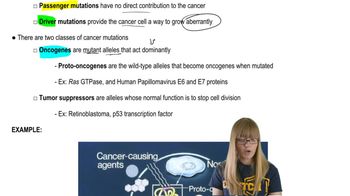Table of contents
- 1. Introduction to Genetics51m
- 2. Mendel's Laws of Inheritance3h 37m
- 3. Extensions to Mendelian Inheritance2h 41m
- 4. Genetic Mapping and Linkage2h 28m
- 5. Genetics of Bacteria and Viruses1h 21m
- 6. Chromosomal Variation1h 48m
- 7. DNA and Chromosome Structure56m
- 8. DNA Replication1h 10m
- 9. Mitosis and Meiosis1h 34m
- 10. Transcription1h 0m
- 11. Translation58m
- 12. Gene Regulation in Prokaryotes1h 19m
- 13. Gene Regulation in Eukaryotes44m
- 14. Genetic Control of Development44m
- 15. Genomes and Genomics1h 50m
- 16. Transposable Elements47m
- 17. Mutation, Repair, and Recombination1h 6m
- 18. Molecular Genetic Tools19m
- 19. Cancer Genetics29m
- 20. Quantitative Genetics1h 26m
- 21. Population Genetics50m
- 22. Evolutionary Genetics29m
17. Mutation, Repair, and Recombination
Types of Mutations
Problem 25b
Textbook Question
Textbook QuestionImagine yourself as one of the team of geneticists who launches a study of the genetic effects of high-energy radiation on the surviving Japanese population immediately following the atom bomb attacks at Hiroshima and Nagasaki in 1945. Demonstrate your insights into both chromosomal and gene mutation by outlining a short-term and long-term study that addresses these radiation effects. Be sure to include strategies for considering the effects on both somatic and germ-line tissues.
 Verified Solution
Verified SolutionThis video solution was recommended by our tutors as helpful for the problem above
Video duration:
2mPlay a video:
Was this helpful?
Key Concepts
Here are the essential concepts you must grasp in order to answer the question correctly.
Chromosomal Mutations
Chromosomal mutations involve changes in the structure or number of chromosomes, which can lead to significant genetic disorders or variations. These mutations can result from high-energy radiation causing breaks in DNA strands, leading to deletions, duplications, or translocations of chromosomal segments. Understanding these mutations is crucial for assessing the immediate and long-term impacts of radiation exposure on the population.
Recommended video:
Guided course

Mutations and Phenotypes
Gene Mutations
Gene mutations are alterations in the nucleotide sequence of a gene, which can affect protein synthesis and function. High-energy radiation can induce point mutations, insertions, or deletions in the DNA sequence, potentially leading to diseases or phenotypic changes. Analyzing gene mutations helps in understanding the molecular basis of radiation effects on individuals and their descendants.
Recommended video:
Guided course

Cancer Mutations
Somatic vs. Germ-line Effects
Somatic mutations occur in non-reproductive cells and affect only the individual, while germ-line mutations occur in reproductive cells and can be passed to offspring. In studying radiation effects, it is essential to differentiate between these two types of mutations, as somatic mutations may lead to cancer or other health issues in survivors, whereas germ-line mutations can have hereditary implications for future generations.
Recommended video:
Guided course

Maternal Effect

 9:49m
9:49mWatch next
Master Point Mutations with a bite sized video explanation from Kylia Goodner
Start learning


